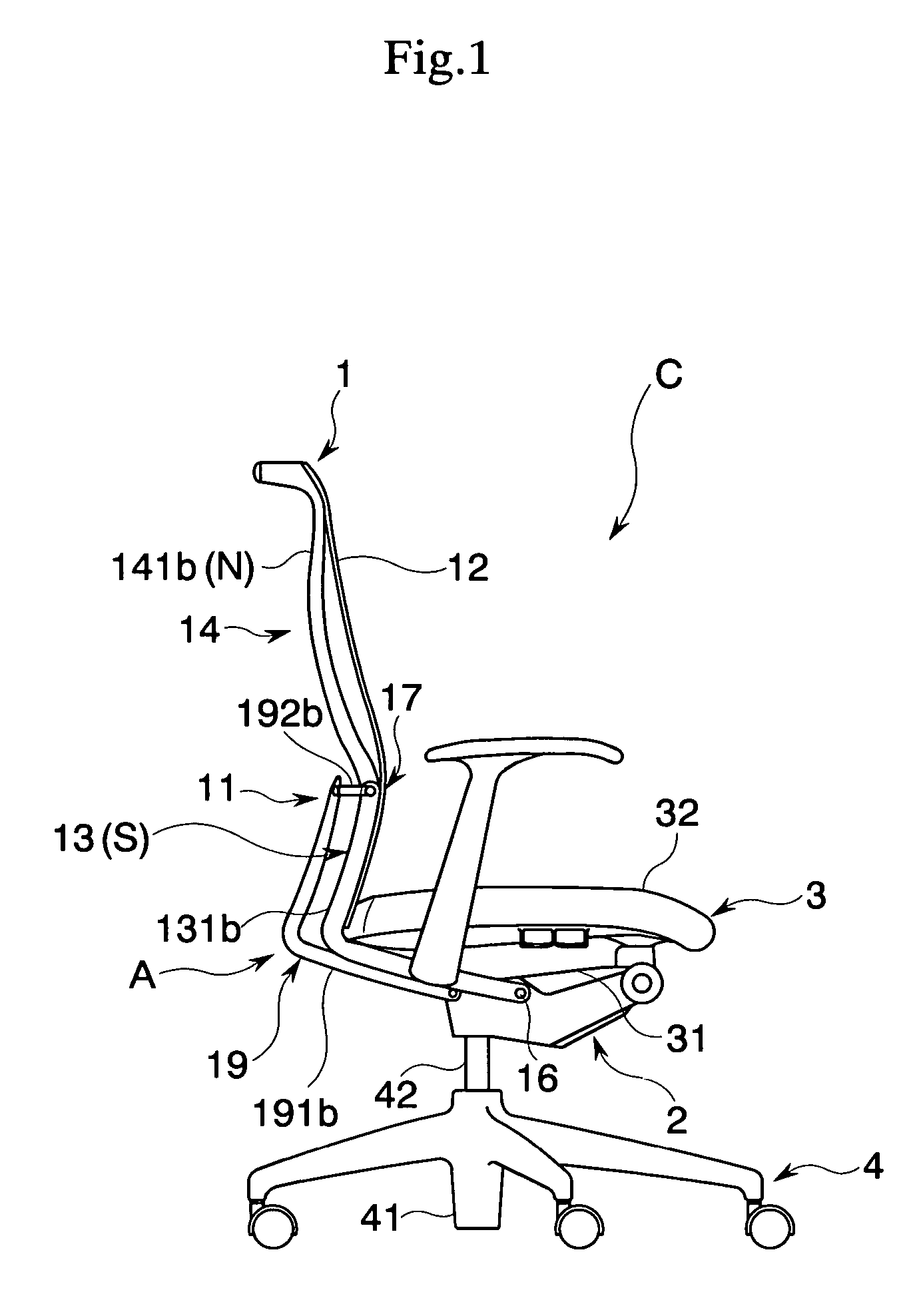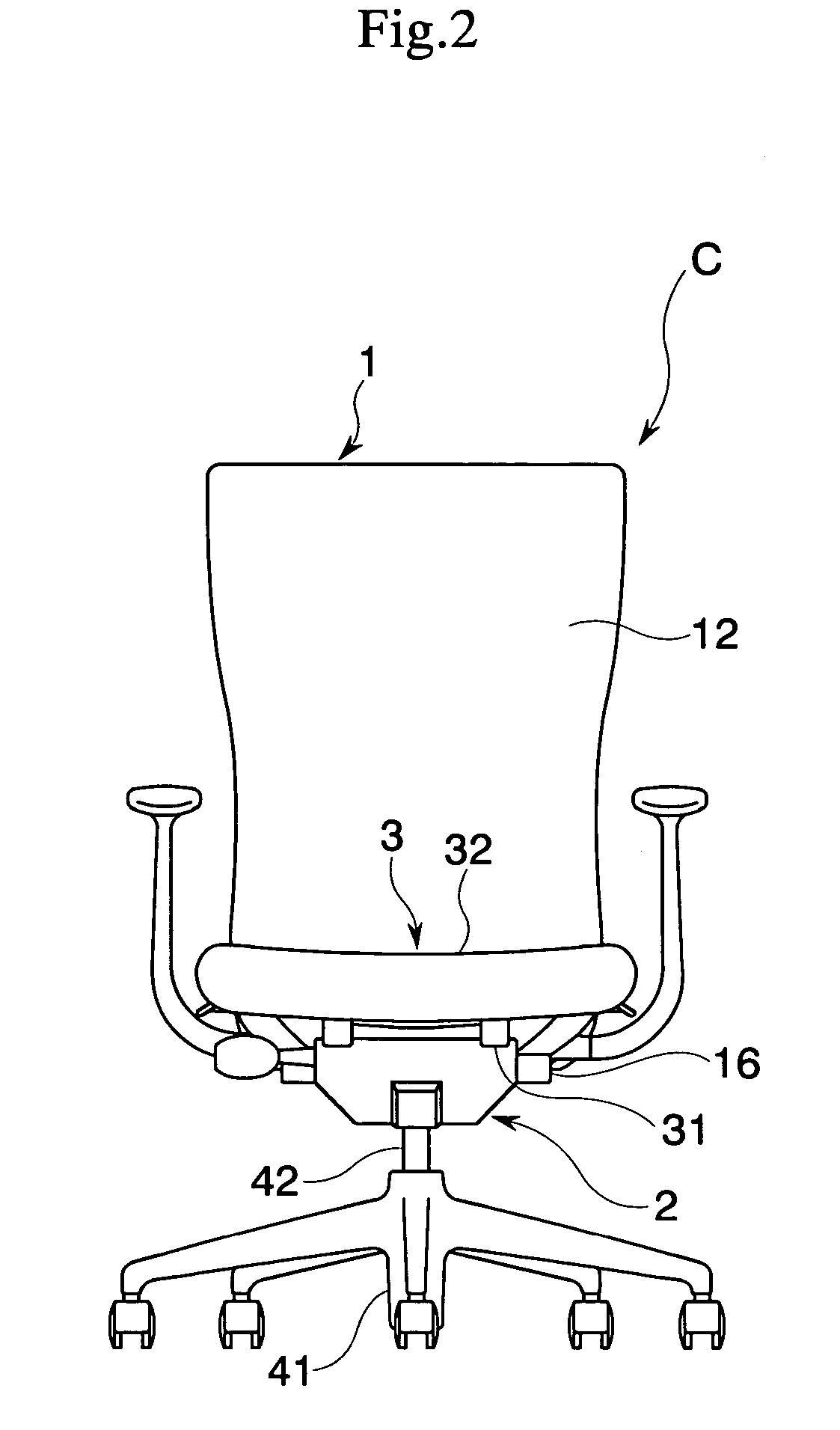Chair
a technology for chairs and seats, applied in the field of chairs, can solve the problems of seating people feeling unstable, and the upper portion of the upper body cannot be supported in a stable manner
- Summary
- Abstract
- Description
- Claims
- Application Information
AI Technical Summary
Benefits of technology
Problems solved by technology
Method used
Image
Examples
first modified example
[0070]It is, for instance, possible to provide a switching mechanism SW for temporality terminating functions of the above-mentioned movement range setting mechanism A as shown in FIG. 13. More concretely explaining, a folding portion 193b is provided proximate of the contacting end portions 191a1, 191b1 of the regulating members 191a, 191b, and by suitably rotating the folding portion 193b, it is possible to switch between an ON condition (ON) in which the contacting end portions 191a1, 191b1 may abut the upper frame elements 141a, 141b and an OFF condition (OFF) in which the butting end portions 191a1, 191b1 may not abut the upper frame elements 141a, 141b as indicated by the dotted line.
[0071]Further, as illustrated in FIG. 14, it is also possible to provide a projecting and sinking regulating portion 194b in the vicinity of the contacting end portions 191a1, 191b1 of the regulating members 191a, 191b, wherein by suitably operating the projecting and sinking regulating portion 19...
second modified example
[0073]It is further possible to further provide an upper frame portion elastically biasing means X1 that elastically biases the upper frame portion 14 from the rear end position (E) to the normal position (N) as illustrated in FIGS. 15 and 16. More particularly, the upper frame portion elastically biasing means X1 is arranged in that elastically biasing force applied to the upper frame portion 14 is set to be larger with the lower frame portion 14 coming closer to the rearward tilting position (T) In other words, as shown in the drawings, the upper frame portion elastically biasing means X1 is mainly comprised of a torsion coil spring 17sp that serves as the elastic member provided between the upper frame portion 14 and the lower frame portion 13, that is, in the vicinity of the hinge 17, wherein one end 171sp of the torsion coil spring 17sp is fixed to the upper frame elements 141a, 141b while the other end 172sp is fixed to the link elements 192a, 192b. When the lower frame portio...
third modified example
[0075]As shown in FIGS. 17 and 18, it is possible to arrange an upper frame portion elastically biasing means X2 as an elastic member by providing a reaction frame portion 15 between the base 2 and the upper frame portion 14.
[0076]The reaction frame portion 15 is comprised of a number of reaction frame elements 151a, 151b corresponding to a number with which each of the upper frame elements 141a, 141b can be supported. One end portion of the reaction frame elements 151a, 151b are joined to the rear surface of the upper frame elements 141a, 141b while the other end is joined to the base 2. The reaction frame elements 151a, 151b might, for instance, be elastic bodies made of the same material resin as the elastic lateral bridging member 142. In the present embodiment, the reaction frame elements 151a, 151b are frame-like resin springs having a substantially L-shaped form extending along the lower frame elements 131a, 131b and the upper frame elements 141a, 141b when seen from a side v...
PUM
 Login to View More
Login to View More Abstract
Description
Claims
Application Information
 Login to View More
Login to View More - R&D
- Intellectual Property
- Life Sciences
- Materials
- Tech Scout
- Unparalleled Data Quality
- Higher Quality Content
- 60% Fewer Hallucinations
Browse by: Latest US Patents, China's latest patents, Technical Efficacy Thesaurus, Application Domain, Technology Topic, Popular Technical Reports.
© 2025 PatSnap. All rights reserved.Legal|Privacy policy|Modern Slavery Act Transparency Statement|Sitemap|About US| Contact US: help@patsnap.com



